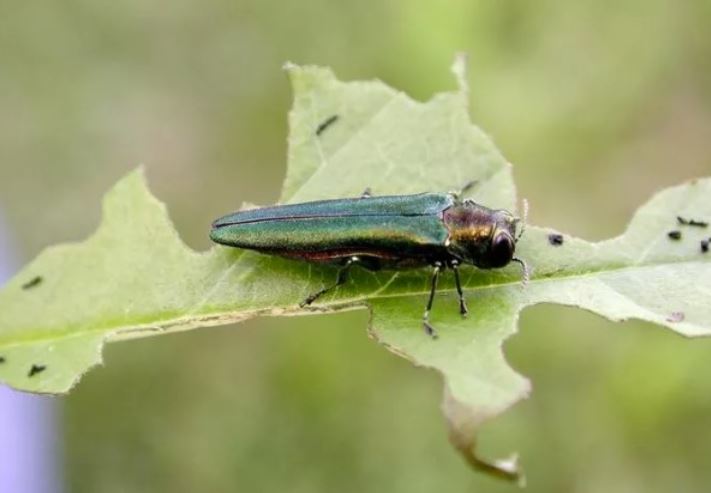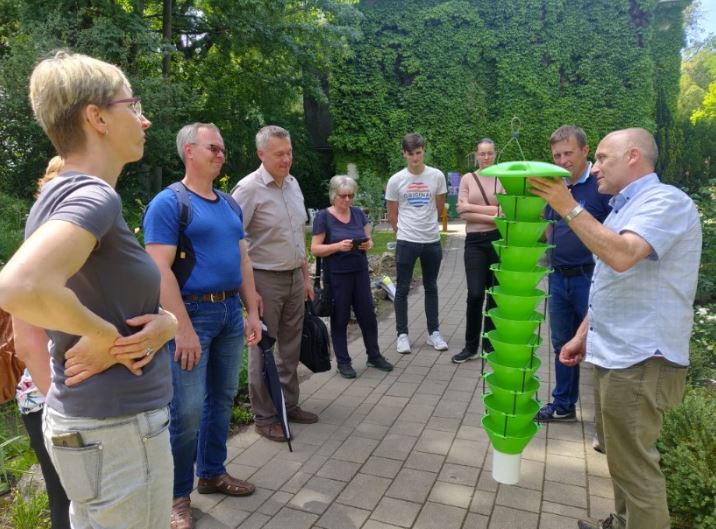IPSN: Holding back a beetle
-
Region
Europe -
Programme
International Plant Sentinel Network -
Workstream
Addressing Global Challenges -
Topic
Plant Conservation -
Type
Blog -
Source
BGCI
News published: 15 September 2023
News about the environment has seemed overwhelmingly depressing for almost as long as I can remember. Biodiversity loss, deforestation, pollution, invasive species, and all of it worsened by climate change – it’s rarely good news. But my time interning for BGCI has reminded me that even amidst this seemingly endless torrent of loss, there are people doing meaningful work to hold back the tide.
In this case, they’re specifically holding back a beetle. A small, slender beetle with a shimmering blue-green carapace: the emerald ash borer. Native to east Asia, these insects feed on the delicate, growing layer of wood in ash trees.

The beetle was introduced to North America in the early 1990s, stowed away on wooden pallets that were shipped in from Asia. Since being formally observed and reported in Michigan in 2002, emerald ash borer beetles have decimated ash populations across the American northeast, killing tens of millions of trees. Their presence is characteristically difficult to detect, as trees that harbor beetle infestations don’t show signs of distress until they are long past the point of saving. Dr. Deb McCullough, a professor of forest entomology commenting for a Michigan State University news report, said that the emerald ash borer is “the most destructive and costly forest insect to ever invade North America.”
And now, the emerald ash borer is headed for Europe.
It’s creeping out of its native range across the Eurasian landmass with a natural dispersal rate of about 40 kilometers per year. It also takes advantage of human transit routes, hitchhiking on wooden pallets that are trucked along highways. With all this movement, the beetles have currently been detected as far west as Ukraine, threatening to destroy ash populations on yet another continent.
At first glance, this story seems bleak; just another example of environmental devastation.
But BGCI’s International Plant Sentinel Network (IPSN) is hard at work here, overseeing efforts to trace, track, and manage the emergence of the emerald ash borer in Europe. Perhaps unsurprisingly, botanic gardens are an ideal site to monitor ash trees, as well-identified individual trees are tended to by dedicated groups of garden staff. Katherine O’Donnell, then coordinator of the IPSN, explained in a workshop that these monitoring efforts are structured to make use of existing staff expertise and familiarity with their collections. While garden employees may not have formal training in plant health, they have important, grounded understandings of the plants they look after, and know when things aren’t right. “Really,” she says, “what the IPSN is trying to do is to tap into that knowledge.”
So far, the project has brought together people from 45 gardens across 13 countries to a network monitoring more than 400 trees across the continent. The IPSN has provided both online and in-person workshops on emerald ash borer beetles, tree health diagnostics, insect trapping to help equip partners with the skills to participate.

Now, once the beetles are detected, there is a program and plan in place to start management efforts and alert neighboring communities, aiming to slow or halt the spread of the ash borer right as it appears.
Lara Salido, who also works for BGCI coordinating this network, says that she has been blown away by the dedication, enthusiasm, and sense of community that emerged from the project. Botanic garden staff are increasingly confident in their diagnostic capacities, excited by the opportunities for further learning, and empowered to maintain the monitoring efforts.
Eventually, the emerald ash borer will crawl its way into Europe. That seems inevitable. But with eyes on the ground, continued research on management strategies, and a resilient network in place to exchange information, we are in the best position available to limit the devastation they cause. Amidst a sea of environmental change and loss, this network is an example of botanic gardens coming together in an effort that will benefit the entire continent – offering a small, blue-green glimmer of hope for the future.
This blog was written by Naomi Murray, an intern with BGCI for Summer 2023. Her work was invaluable to the Education and Communications teams during her short time with us. Naomi came to us as a part of her Science Communications qualification at Imperial College London and we thank her very much for the time and effort she put in to help us reach our conservation goals as an organisation.
Become a Member
Be part of the largest network of botanic gardens and plant conservation experts in the world by joining BGCI today!
Conservation Action Tracker
BGCI’s Conservation Action Tracker provides information on conservation actions for tree species.